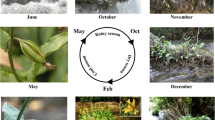Abstract
Gastrodia elata must establish symbiotic associations with different compatible fungi at seed germination and during vegetative growth. One of the major problems associated with its field production is the degeneration of tubers, which is mainly caused by multiple regeneration via vegetative propagation using immature tubers. To overcome this problem, an in vitro asexual propagation method via artificial pollination was developed. Seeds were first germinated on medium containing a leaf-disc from four different Quercus species, previously infected with Mycena osmundicola. Among the four species tested, Q. acutissima was determined to be the best organic resource and the germination rate reached up to 40.4% when a leaf-disc (2 × 2 cm) was provided. Subsequent infection with Armillaria mellea allowed the protocorms to further develop into immature tubers, which can be directly used for field production. In this study, we established an in vitro symbiotic propagation system of G. elata, which might be an efficient way to prevent degeneration of G. elata tubers and the reduction of yield in the field.
Similar content being viewed by others
Literature Cited
Bidartondo, M.I. 2005. The evolutionary ecology of myco-heterotrophy. New Phytol. 167:335–352.
Bidartondo, M.I. and T.D. Bruns. 2001. Extreme specificity in epiparasitic Monotropoideae (Ericaceae): Widespread phylogenetic and geographical structure. Mol. Ecol. 10:2285–2295.
Chang, H.M. and P.H. But. 1986. Pharmacology and application of Chinese materia medica, Vol. 1. World Scientific, Singapore.
Clements, M.A., H. Muir, and P.J. Cribb. 1986. A preliminary report on the symbiotic germination of European terrestrial orchids. Kew. Bull. 41:437–445.
Huang, Z.L. 1985. Pharmacologic studies and clinical applications of Gastrodia elata Bl. J. Modern Develop. Trad. Media 5:251–254.
Kikuchi, G., M. Higuchi, H. Yoshimura, T. Morota, and A. Suzuki. 2008. In vitro symbiosis between Gastrodia elata Blume (Orchidaceae) and Armillaria Kummer (Tricholomataceae) species isolated from the orchid tuber. J. Jap. Bot. 83:77–87.
Kikuchi, G., M. Higuchi, T. Morota, E. Nagasawa, and A. Suzuki. 2008. Fungal symbiont and cultivation test of Gastrodia elata Blume (Orchidaceae). J. Jap. Bot. 83:88–95.
Kim, Y.I., K.J. Chang, K.H. Ka, H. Hur, I.P. Hong, J.O. Shim, T.S. Lee, J.Y. Lee, and M.W. Lee. 2006. Seed germination of Gastrodia elata using symbiotic fungi, Mycena osmundicola. Mycobiology 34:79–82.
Kusano, S. 1911. Gastrodia elata and its symbiotic association with Armillaria mellea. Imperial Univ. Tokyo J. College Agr. 4:1–65.
Leake, J.R. 1994. The biology of myco-heterotrophic (’saprophytic’) plants. New Phytol. 127:171–216.
Leake, J.R. 2005. Plants parasitic on fungi: unearthing the fungi in myco-heterotrophys and debunking the ’saprophytic’ plant myth. Mycol. 19:113–122.
Liu, H., C. Feng, Y.B. Luo, B.S. Chen, Z.S. Wang, and H.Y. Gu. 2010. Studies of mycorrhizal fungi of Chinese orchids and their role in orchid conservation in China A review. Bot. Rev. 76: 241–262.
McKendrick, S.L., J.R. Leake, D.L. Taylor, and D.J. Read. 2000. Symbiotic germination and development of myco-heterotrophic plants in nature: Ontogeny of Corallorhiza trifida and characterization of its mycorrhizal fungi. New Phytol. 145:523–537.
Rasmussen, H.N. 1995. Terrestrial orchids from seed to mycotrophic plant. Cambridge University Press, Cambridge.
Rasmussen, H.N. and F.N. Rasmussen. 2009. Orchid mycorrhiza: Implications of a mycophagous life style. Oikos 118:334–345.
Smith, S.E. and D.J. Read. 1997. Mycorrhizal symbiosis. 2nd ed. Academic Press, San Diego.
Umata, H. 1997. Formation of endomycorrhizas by an achlorophyllous orchid, Erythrorchis ochobiensis, and Auricularia polytricha. Mycoscience 38:335–339.
Yagame, T., M. Yamato, M. Mii, A. Suzuki, and K. Iwase. 2007. Developmental processes of achlorophyllous orchid, Epipogium roseum: Form seed germination to flowering under symbiotic cultivation with mycorrhizal fungus. J. Plant Res. 120:229–236.
Xu, J.T. and S.X. Guo. 2000. Retrospect on the research of the cultivation of Gastrodia elata Bl, a rare traditional Chinese medicine. Chin. Med. J. 113:686–692.
Xu, J.T. and S.X. Guo. 1991. The relationship of nutrient between Gastrodia elata — Mycena osmundicola and Armillaria mella and its application in the cultivation. J. Med. Res. 1:31–32.
Zou, N., X. Bai, J. Lv, J. Yang, G. Xu, and D. Sun. 2010. Study on symbiotic mechanism between Gastrodia elata Blume and Armillaria mellea in tissue culture system. Medicinal Plant 1:91–92.
Author information
Authors and Affiliations
Corresponding author
Rights and permissions
About this article
Cite this article
Park, EJ., Lee, W.Y. & Ahn, J.K. In vitro propagation of myco-heterotrophic Gastrodia elata . Hortic. Environ. Biotechnol. 53, 415–420 (2012). https://doi.org/10.1007/s13580-012-0046-y
Received:
Revised:
Accepted:
Published:
Issue Date:
DOI: https://doi.org/10.1007/s13580-012-0046-y




